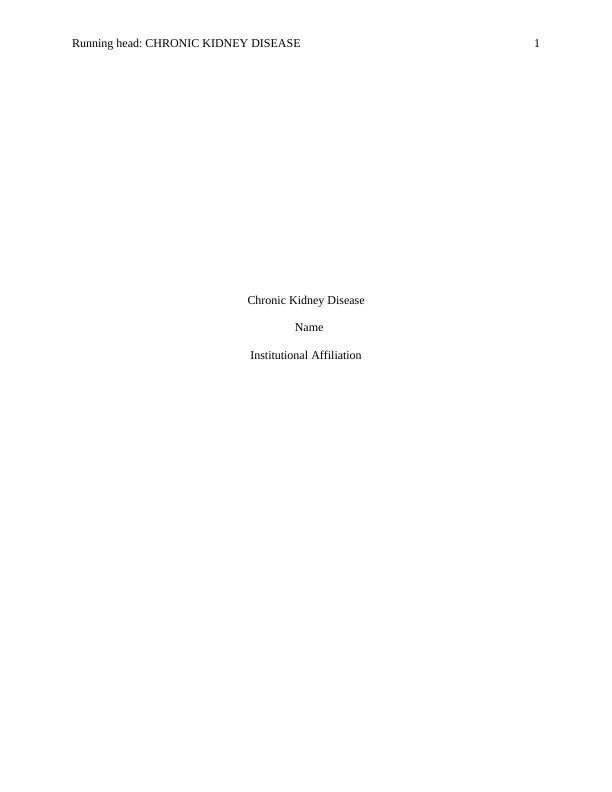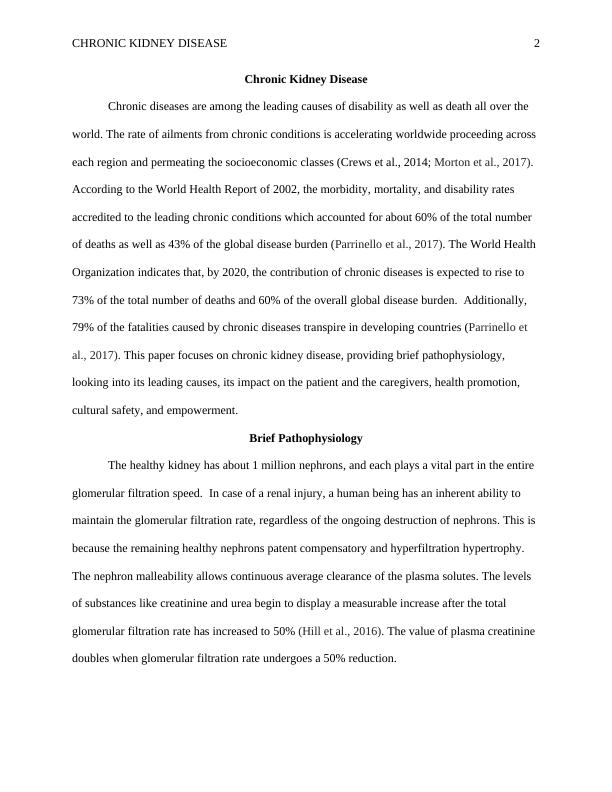Chronic Kidney Disease
Added on 2022-12-14
10 Pages3033 Words383 Views
Running head: CHRONIC KIDNEY DISEASE 1
Chronic Kidney Disease
Name
Institutional Affiliation
Chronic Kidney Disease
Name
Institutional Affiliation

CHRONIC KIDNEY DISEASE 2
Chronic Kidney Disease
Chronic diseases are among the leading causes of disability as well as death all over the
world. The rate of ailments from chronic conditions is accelerating worldwide proceeding across
each region and permeating the socioeconomic classes (Crews et al., 2014; Morton et al., 2017).
According to the World Health Report of 2002, the morbidity, mortality, and disability rates
accredited to the leading chronic conditions which accounted for about 60% of the total number
of deaths as well as 43% of the global disease burden (Parrinello et al., 2017). The World Health
Organization indicates that, by 2020, the contribution of chronic diseases is expected to rise to
73% of the total number of deaths and 60% of the overall global disease burden. Additionally,
79% of the fatalities caused by chronic diseases transpire in developing countries (Parrinello et
al., 2017). This paper focuses on chronic kidney disease, providing brief pathophysiology,
looking into its leading causes, its impact on the patient and the caregivers, health promotion,
cultural safety, and empowerment.
Brief Pathophysiology
The healthy kidney has about 1 million nephrons, and each plays a vital part in the entire
glomerular filtration speed. In case of a renal injury, a human being has an inherent ability to
maintain the glomerular filtration rate, regardless of the ongoing destruction of nephrons. This is
because the remaining healthy nephrons patent compensatory and hyperfiltration hypertrophy.
The nephron malleability allows continuous average clearance of the plasma solutes. The levels
of substances like creatinine and urea begin to display a measurable increase after the total
glomerular filtration rate has increased to 50% (Hill et al., 2016). The value of plasma creatinine
doubles when glomerular filtration rate undergoes a 50% reduction.
Chronic Kidney Disease
Chronic diseases are among the leading causes of disability as well as death all over the
world. The rate of ailments from chronic conditions is accelerating worldwide proceeding across
each region and permeating the socioeconomic classes (Crews et al., 2014; Morton et al., 2017).
According to the World Health Report of 2002, the morbidity, mortality, and disability rates
accredited to the leading chronic conditions which accounted for about 60% of the total number
of deaths as well as 43% of the global disease burden (Parrinello et al., 2017). The World Health
Organization indicates that, by 2020, the contribution of chronic diseases is expected to rise to
73% of the total number of deaths and 60% of the overall global disease burden. Additionally,
79% of the fatalities caused by chronic diseases transpire in developing countries (Parrinello et
al., 2017). This paper focuses on chronic kidney disease, providing brief pathophysiology,
looking into its leading causes, its impact on the patient and the caregivers, health promotion,
cultural safety, and empowerment.
Brief Pathophysiology
The healthy kidney has about 1 million nephrons, and each plays a vital part in the entire
glomerular filtration speed. In case of a renal injury, a human being has an inherent ability to
maintain the glomerular filtration rate, regardless of the ongoing destruction of nephrons. This is
because the remaining healthy nephrons patent compensatory and hyperfiltration hypertrophy.
The nephron malleability allows continuous average clearance of the plasma solutes. The levels
of substances like creatinine and urea begin to display a measurable increase after the total
glomerular filtration rate has increased to 50% (Hill et al., 2016). The value of plasma creatinine
doubles when glomerular filtration rate undergoes a 50% reduction.

CHRONIC KIDNEY DISEASE 3
The hypertrophy and hyperfiltration of remaining nephrons have been conjectured as a
representation of a leading cause of liberal renal dysfunction. In case of an increase in the
pressure of the glomerular capillaries, the capillaries might get damaged, which leads to
secondary segmental and focal glomerulosclerosis and ultimately to global glomerulosclerosis.
There are other factors other than the underlying process of the disease as well as glomerular
hypertension which might cause progressive chronic kidney disease (Khan & Khan, 2015).
These factors include a decrease in perfusion, for instance, from severe dehydration or even
shock episodes, systemic hypertension, nephrotoxins such as nonsteroidal anti-inflammatory
drugs, smoking, hyperlipidemia uncontrolled diabetes and hyperphosphatemia with the
deposition of calcium phosphate
There is a massive association between acute kidney injury and accumulative risk for
advanced chronic kidney disease development in patients who have diabetes mellitus who have
experienced acute kidney injury. Severe kidney injury is a risk factor of chronic kidney disease
in stage 4, with each additional acute kidney injury episode doubling the risk (Hill et al., 2016).
Additionally, hemostasis and inflammation are predecessor pathways to acquiring chronic
kidney disease.
Causes of Chronic Kidney Disease
High blood pressure and diabetes are the leading causes of chronic kidney disease
(Ghaderian & Beladi-Mousavi, 2014). The healthcare provider looks at a patient’s health history
and does tests to find out why one has kidney disease. The cause of a patient’s kidney disease
has an effect on the type of treatment one receives.
If an individual has too much glucose in their blood, the kidney filters are damaged. With
time, the patient’s kidney can become damaged to the extent of failing to perform their function
The hypertrophy and hyperfiltration of remaining nephrons have been conjectured as a
representation of a leading cause of liberal renal dysfunction. In case of an increase in the
pressure of the glomerular capillaries, the capillaries might get damaged, which leads to
secondary segmental and focal glomerulosclerosis and ultimately to global glomerulosclerosis.
There are other factors other than the underlying process of the disease as well as glomerular
hypertension which might cause progressive chronic kidney disease (Khan & Khan, 2015).
These factors include a decrease in perfusion, for instance, from severe dehydration or even
shock episodes, systemic hypertension, nephrotoxins such as nonsteroidal anti-inflammatory
drugs, smoking, hyperlipidemia uncontrolled diabetes and hyperphosphatemia with the
deposition of calcium phosphate
There is a massive association between acute kidney injury and accumulative risk for
advanced chronic kidney disease development in patients who have diabetes mellitus who have
experienced acute kidney injury. Severe kidney injury is a risk factor of chronic kidney disease
in stage 4, with each additional acute kidney injury episode doubling the risk (Hill et al., 2016).
Additionally, hemostasis and inflammation are predecessor pathways to acquiring chronic
kidney disease.
Causes of Chronic Kidney Disease
High blood pressure and diabetes are the leading causes of chronic kidney disease
(Ghaderian & Beladi-Mousavi, 2014). The healthcare provider looks at a patient’s health history
and does tests to find out why one has kidney disease. The cause of a patient’s kidney disease
has an effect on the type of treatment one receives.
If an individual has too much glucose in their blood, the kidney filters are damaged. With
time, the patient’s kidney can become damaged to the extent of failing to perform their function

End of preview
Want to access all the pages? Upload your documents or become a member.
Related Documents
Risk factors and etiology of the patient Case Study 2022lg...
|7
|1770
|16
Healthcare. Student's Name. Institutional Affiliation. lg...
|12
|3137
|1
ADVANCED PATHOPHYSIOLOG DISCUSSION 2022lg...
|14
|3317
|28
Pathophysiology of Obesity and Diabetic Kidney Diseaselg...
|3
|1605
|40
Chronic Kidney Disease: Case Study and Discussionlg...
|5
|1570
|166
Disease Pathophysiology and Concept Maplg...
|9
|2013
|309
